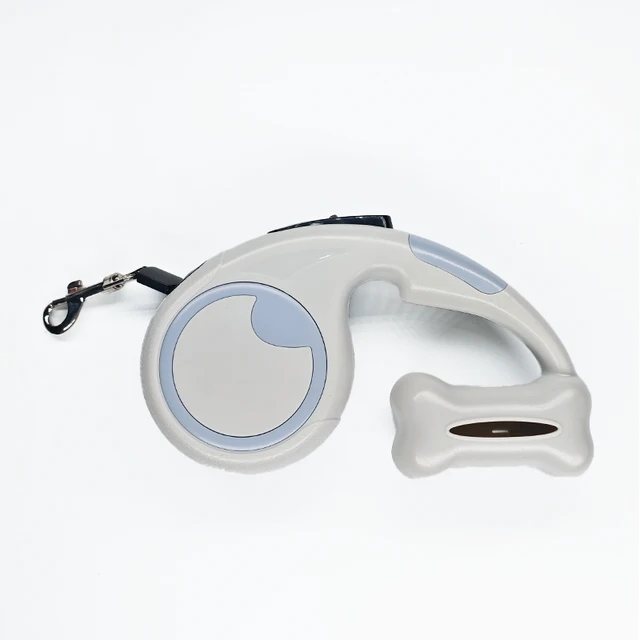The Concept and Popularity of Retractable Leashes
Retractable dog leashes gained popularity for a simple reason. They promise more freedom for dogs on walks. With a button, owners can let their dogs explore with controlled leash lengths. This idea seemed perfect for dogs who like to wander. Flexi-leashes, as some call them, also seemed great for dog training. They allow for varying distances, up to 26 feet in some cases. The market has many retractable leash options, appealing to different dog sizes. Despite their popularity, experts have raised concerns. They say that retractable leashes come with risks. These risks include potential injury and decreased control for the owner. This blog will delve into why retractable leashes might not be the best choice.
Risks of Extending Too Much Freedom
The allure of giving dogs more freedom on walks is understandable.owners love watching their pets explore. Retractable leashes may seem like the perfect solution, but they come with significant risks. Here’s why extending too much freedom to your dog might be a bad idea.
Potential for Loss of Control and Accidents
Retractable leashes can extend up to 26 feet. This distance allows dogs to move far from their owners. The risk of dogs running into traffic or getting into fights increases. It’s harder to control a situation when your dog is 20 feet away. A quick jerk can snap the cord, leaving your dog unleashed and vulnerable.
Physical Injuries Associated with Retractable Leashes
Retractable leashes pose dangers to both dogs and owners. The thin cords can cause burns, cuts, or even amputation if tangled or grabbed. A dog could suffer neck injuries or worse from a sudden stop. Owners may face similar consequences, including falls and fractures.

Retractable Leashes Can Encourage Negative Behaviors
Retractable leashes may train dogs to pull. This happens because the leash extends when they do. Over time, this encourages poor leash manners. The constant tension can also confuse dogs during training.
Challenges in Leash Handling and Management
Owners find retractable leashes tough to handle. The bulky handle and extending mechanism are cumbersome. It can also be dangerous if another pet or a person gets tangled in the leash.
The Impact on Dog Training and Leash Manners
A retractable leash’s constant tension contradicts traditional training. Dogs should learn to walk without pulling. That is difficult with a leash that rewards pulling by giving more slack.
In summary, retractable leashes may compromise safety and training. They can lead to accidents, injuries, and negative behaviors. This insight shows why retractable leashes are bad for dog walking. Next, we will look at safer alternatives for responsible pet ownership.
Potential for Loss of Control and Accidents
Retractable leashes go as far as 26 feet. This can put dogs in risky situations. They might dash into traffic or confront aggressive dogs. With distance, you lose quick control over your dog. It gets tough to manage situations that happen away from you. A sudden move might break the leash. This can leave your dog free and in danger. Plus, the snapped leash can hurt people around.
Retractable leashes pose a real problem. They trick owners into a false sense of security. You might think you have control with the button. But in an instant, your dog could be facing harm. Consider this when choosing a leash for safety and peace of mind.
Physical Injuries Associated with Retractable Leashes
The hidden dangers of retractable leashes often lead to physical injuries for both dogs and their owners. The mechanism of these leashes can create a deceptive feeling of safety. However, accidents stemming from their use are not rare. When discussing why retractable leashes are bad, it’s important to highlight several common injuries.
Burns and Cuts
The leash’s thin cord can move at high speeds. This can cause rope burns or cuts on your skin. The dog can also suffer from these injuries if the cord wraps around them.
Severe Wounds and Amputations
In extreme cases, the cord can wrap tightly enough to cause amputation. This is especially risky if you grab the leash during a moment of panic.
Neck and Spinal Injuries
When dogs reach the end of the leash at full speed, the sudden stop can injure their neck and spine. This happens because of the harsh yanking motion at the end of the leash’s length.
Bone Fractures and Falls
Owners can get pulled to the ground if their dog lunges suddenly. This might lead to broken bones or other serious injuries.
Handle-Related Injuries
The bulky handles of retractable leashes can slip from grip easily. If dropped, they might hit a person or dog, causing further injury.
In summary, retractable leashes pose various risks that can lead to significant injury. These incidents are among the reasons why retractable leashes are bad for owners looking to keep themselves, and their dogs, safe during walks.

Retractable Leashes Can Encourage Negative Behaviors
Retractable leashes may seem helpful, but they often lead to poor leash habits. These are the reasons:
Encouragement to Pull
The design of retractable leashes rewards dogs for pulling. When dogs pull, the leash extends, sending a wrong message. This behavior goes against proper leash manners.
Confusion During Training
Training your dog to walk without tension is crucial. Retractable leashes apply constant pressure, confusing the training process. Dogs struggle to associate tension with commands.
Masking True Temperament
Retractable leashes can make it hard to read your dog’s body language. Tension can be mistaken for aggression by other dogs. This can lead to unwanted encounters.
Habit of Ignoring Owners
Dogs can become used to the freedom and ignore recall commands. They learn that the leash’s length is not a boundary. This can create dangerous situations.
In conclusion, retractable leashes may teach dogs bad behaviors. These habits can make walks more challenging. Stick with training for loose leash walking. It will lead to better control and a happier walking experience.
Challenges in Leash Handling and Management
Retractable leashes come with their set of challenges, especially in terms of handling and managing them effectively. Here are some of the difficulties that dog owners might encounter:
Bulky Handles and Complex Mechanisms
The handles of retractable leashes are often large and unwieldy. This makes it difficult for owners to maintain a good grip, especially in situations that require quick action. Additionally, the internal mechanisms that allow the leash to extend and retract can be complex. They may malfunction, leaving you with a stuck leash when you need to quickly adjust the length.
Tangles and Entanglements
One of the common problems with retractable leashes is the ease with which they can become tangled. If a dog circles around an object or a person, the thin cord can quickly create a hazardous situation. Untangling the cord, while keeping control of your dog, can be stressful and dangerous.
Difficult Transfers
Switching a retractable leash from hand to hand during a walk can be tricky. This is due to the size and shape of the handle. The challenge increases if you need to pick up after your dog or perform other tasks.
Communication Issues
A leash is a key communication tool between a dog and its owner. Retractable leashes can interfere with this communication, especially if the leash is always tight. This tension can prevent dogs from understanding their boundaries and responding to owner cues.

Walking Multiple Dogs
Using retractable leashes for walking more than one dog is often impractical. Trying to manage multiple cords and handles can lead to a tangled mess and a loss of control. It can be nearly impossible to manage the dogs effectively.
These challenges highlight why retractable leash are problematic for owners. Proper leash handling is crucial for a safe and enjoyable walk. Next, we will explore the influence of retractable leashes on dog training and leash manners.
The Impact on Dog Training and Leash Manners
Retractable leashes may hinder training progress. The tension teaches dogs that pulling is okay. This goes against what trainers teach for loose leash walking. Here’s how retractable leashes can complicate training and impact leash manners.
Confusion in Training Cues
Retractable leashes stay tight, confusing dogs. They struggle to learn cues for direction changes or stops. The leash doesn’t slacken, so dogs don’t learn to walk calmly by your side.
Poor Leash Manners Development
Dogs may develop bad habits, like pulling. The leash extending rewards this behavior. This can make walking your dog more difficult. It goes against the goal of teaching them to walk without pulling.
Mixed Signals Lead to Tension
Constant leash tension can make dogs tense. They may react poorly to other dogs or people. This can increase the risk of negative encounters or aggression.
Loss of Focus on the Owner
Dogs may ignore recall commands. They learn to enjoy the freedom and forget to listen. They might think leash length is not a limit. This can lead to dangerous situations.
In conclusion, retractable leashes may do more harm than good in training. They teach dogs the wrong habits and can lead to safety risks. It’s important for dogs to learn good leash manners for a better walking experience. Stick with traditional training methods for this.
Alternatives to Retractable Leashes for Dog Owners
Given the risks outlined above, dog owners should consider safer alternatives to retractable leashes. Here are options that provide security and control.
Standard Flat Leashes
These are traditional leashes, usually around 4 to 6 feet in length. They allow for easy handling and clear communication between you and your dog. They are great for training and everyday walks.
Adjustable Leashes
Adjustable leashes have loops or clips for changing length. This allows for more freedom when safe, without the risks of retractable leash. They are versatile and easy to use.
Long Lines or Check Cords
Long lines, also called check cords, can be 10 feet or longer. They work well in open spaces where your dog has more leeway to explore but still needs to be on a leash.
Harnesses with Built-in Short Leashes
Some harnesses come with short leashes for greater control in crowded or potentially risky areas. They are useful for dogs who need to stay close.
Double-ended Leashes
These leashes have clips on both ends and rings along the length. They can be used in many different ways, adjusting for the environment and training needs.
Slip Leads
Slip leads tighten slightly when a dog pulls, giving a gentle correction. They are useful for dogs still learning not to pull but should be used carefully.
Traffic Leads
Traffic leads are very short leashes, giving owners control in tight spots. They are good for walking in busy streets or crowded places.
By choosing the right leash for your situation, you can ensure your dog’s safety and enhance their training. Remember, the key is consistent, positive training to promote good leash manners. A well-trained dog is a joy to walk, with any leash.










